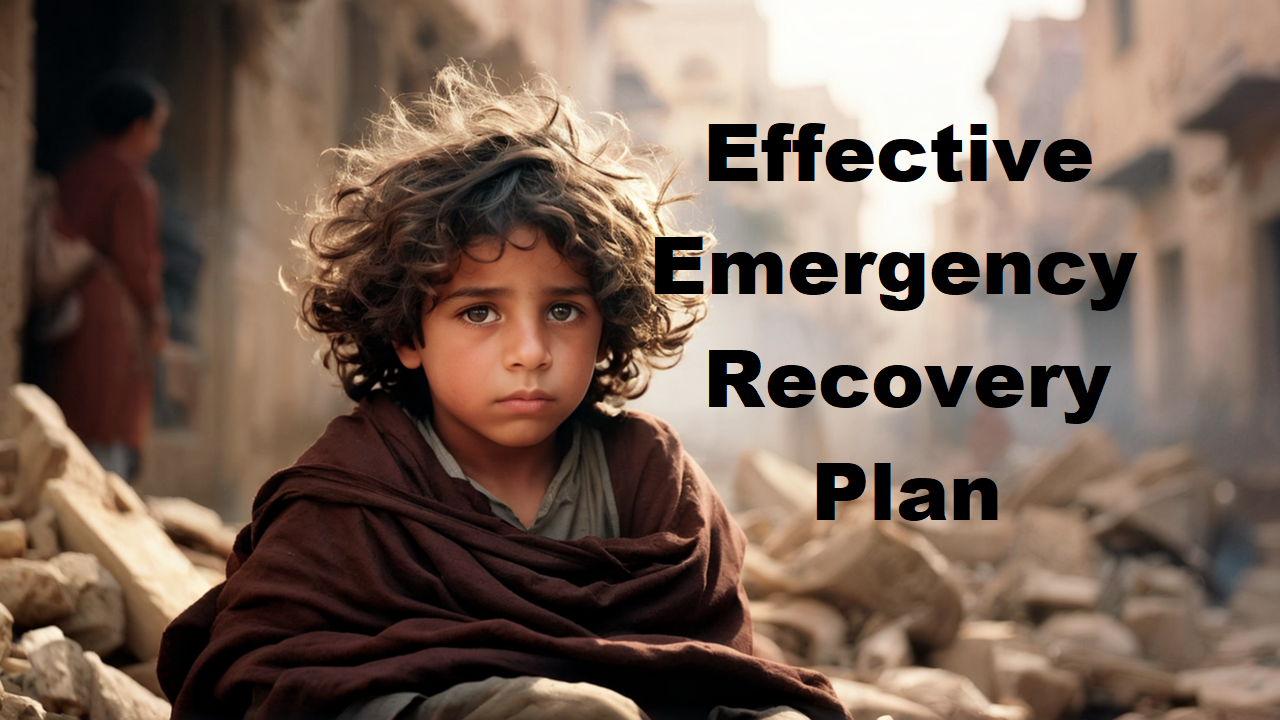Effective Emergency Recovery Plan in Disaster Management
A good emergency recovery plan in disaster management is an important factor in mitigating the long-term effects of disasters. First, disaster management is all about proactive planning that will allow communities to recover fast and effectively from natural or human-induced calamities.
In addition, a good recovery plan addresses not just the basic needs like food, shelter, and medicine but also restoring infrastructure, livelihoods, and psyches. Moreover, it institutes coordination between government agencies, NGOs, and local communities, thus ensuring prudent and equitable utilization of resources.
In addition, by incorporating technology, early warning systems, and community participation, disaster management enhances resilience and gets societies ready to face future emergencies.
As a result, such a plan converts chaos to systematic recovery, mitigates vulnerabilities, and expedites the way towards normalcy. Finally, a successful recovery plan in emergency situations during disaster management becomes the cornerstone for sustainable development and future safety.
Effective Emergency Recovery Plan in Disaster Management
1. Introduction to Emergency Recovery
Emergency recovery in disaster management is crucial to restoring normalcy after the crisis.
First, disaster management not only concentrates on response but also on systematic recovery to guarantee long-term resilience.
Secondly, emergency recovery meets the instant needs of affected people, including food, water, shelter, and health, while at the same time preparing for
rehabilitation and reconstruction.
Besides, it also fills the gap between sustainable development and emergency relief by facilitating community mobilization, resource mobilization, and joint
action among stakeholders.
In addition, recovery planning is made efficient by incorporating contemporary technology, risk evaluation, and capacity development, thus minimizing
future risks.
As a result, emergency recovery becomes an essential process of disaster management that converts reactive responses into proactive strategies.
In the end, disaster management builds on resilience and thus reduces losses, sustains livelihoods, and enables communities to recover and thrive even
in the midst of repeated disasters.
Objectives of a Successful Emergency Recovery Plan
The goals of a successful emergency recovery plan in disaster management are centered on loss minimization and speedy restoration.
To start with, the plan is to offer relief to the affected peoples immediately by providing food, water, shelter, and healthcare. In addition,
it seeks to reconstruct essential infrastructure like transport, communication, power, and health facilities. Apart from this, the plan focuses on livelihood
rehabilitation by facilitating employment, education, and community services.
In addition, it aims to reduce future risk by incorporating disaster-resilient designs within reconstruction efforts. Another prime focus is to enhance
coordination among government institutions,
NGOs, and local communities, thus allowing optimal use of resources.
As a result, the plan not only responds to emergency needs but also sets the stage for long-term development and resilience.
Finally, the goals of a successful emergency recovery plan in disaster management protect human life while ensuring sustainable and inclusive recovery.
Stages of Disaster Management and Recovery
The disaster management and recovery phases emphasize a methodical process of reducing damage and achieving stability.
In the first place, the mitigation stage ensures risk reduction through safety precautions, enforcement of building regulations, and awareness campaigns.
Furthermore, the preparedness stage enhances preparedness through early warning systems, training programs, and drills.
Additionally, the response stage makes sure to take action immediately during a disaster through the delivery of rescue operations, relief commodities, and
medical care.
In addition, the recovery stage is essential in restoring lives, rebuilding infrastructure, and rehabilitating communities.
All stages support each other, thus ensuring a continuum of safety, response, and resilience.
As such, disaster management is improved when recovery incorporates experience from past emergencies.
Ultimately, disaster management and recovery stages convert short-term relief into long-term development, making it possible for communities not only to
endure disasters but also to become stronger and more resilient.
Immediate Relief and Response
Relief and response are the initial and most critical phase of disaster management recovery.
Firstly, this phase aims at rescuing lives by offering basic services like food, clean water, temporary shelter, and emergency medical care.
Additionally, it sends out rescue teams, relief camps, and health workers to stabilize society and avert more casualties.
Additionally, this stage facilitates rapid restoration of communication and transport networks such that relief material reaches affected regions without delay.
Additionally, coordination between the government departments, NGOs, and local volunteers is an essential factor for equitably and efficiently distributing resources.
As a result, prompt relief alleviates panic, meets fundamental human requirements, and lays the basis for the subsequent progress in rehabilitation.
Finally, proper response not only reduces misery but also instills confidence in affected populations that recovery is achievable and support mechanisms
are actively working in their interest.
Rehabilitation and Reconstruction
Rehabilitation and reconstruction constitute the second phase of disaster recovery, with a focus on the rebuilding of communities and restoration of
normalcy.
First, rehabilitation involves short-term necessities like returning electricity, school reopening, resuscitation of healthcare services, and promotion of work
opportunities.
Further, reconstruction prioritizes longer-term rebuilding through house, road, bridge, and public institution repairs.
Additionally, this phase involves disaster-resilient designs, which means ensuring rebuilt infrastructure is resilient against future threats. In addition,
psychological and social support is also essential in that institutions are provided with the necessary support to help disaster-stricken people overcome
trauma and build confidence.
Rehabilitation and reconstruction also promote community engagement, which makes the reconstruction efforts align with local priorities and needs.
As a result, this phase not only restores what was lost but also enhances living standards by implementing safer and sustainable buildings.
Finally, rehabilitation and reconstruction evolve disaster-stricken regions into resilient and stronger communities that are well equipped to handle future
adversities
Long-term Risk Reduction
Long-term risk mitigation is the last and most enduring stage of disaster recovery management.
First, it involves vulnerability identification and preventive measures to minimize future loss.
Further, this phase involves stringent enforcement of building codes, the creation of disaster-resistant structures, and the improvement of early warning
systems.
Furthermore, long-term planning involves training communities, public information programs, and capacity development to enable individuals to be ready
for emergencies.
In addition, risk reduction entails synthesizing environment management, including reforestation, flood control, and sustainable land use, for the reduction
of natural hazards.
Another consideration is policy formulation and resource allocation, which ensure that governments set disaster resilience as a priority in development
planning.
As such, long-term risk reduction shifts recovery measures to sustainable safety measures.
Finally, through investing in prevention and preparedness, communities minimize losses, increase resilience, and ensure that future disasters will not roll
back developmental gains.
This forward-looking strategy saves both lives and livelihoods for generations to come.
Use of Technology in Disaster Management Recovery
Incorporation of technology in disaster relief management assumes a revolutionary role in accelerating response and enhancing resilience.
First, contemporary tools like GIS, drones, and satellite imagery facilitate rapid assessment of damages and determination of areas of precedence for
relief.
In addition, electronic communication platforms allow coordination between government departments, NGOs, and community groups at an accelerated
pace, thus enhancing effectiveness.
Moreover, artificial intelligence and data analytics enable precise forecasting, technical mapping of risks, and resource utilization that reduce delays and
maximize recovery measures.
Additionally, web portals and mobile apps enable residents to report distress, request support, and access information in real time. In addition, technology
fills gaps in information, maximizes transparency, and mitigates effort duplication throughout recovery.
In the end, technology integration in disaster recovery management not only speeds relief and rehabilitation but also builds wiser, safer, and more resilient
communities for the future.
Case Studies of Effective Emergency Recovery Plans
Successful emergency recovery cases serve important lessons for disaster management and future preparedness.
Firstly, the Odisha Super Cyclone of 1999 shows how planning ahead, early warning, and active people participation reduced casualties and hastened
recovery.
Furthermore, the 2015 Nepal Earthquake underscores the efficiency of joint endeavor by government institutions, NGOs, and international bodies in
restoring infrastructure and livelihoods.
Also, the Kerala Floods of 2018 demonstrate how technology, for instance, satellite imaging and real-time monitoring, aided effective resource distribution
and quick response.
Above all, case studies highlight the significance of long-term risk reduction, for example, resilient infrastructure and disaster-conscious communities, in
reducing future losses.
As a result, extracting lessons from these examples enables policymakers and practitioners to adopt successful strategies and prevent past errors.
Eventually, effective recovery cases based on successful emergency plans inform disaster management, enhance resilience, and empower communities
to recover more rapidly and sustainably.
Stakeholder’s Role in Emergency Recovery
Government Agencies
Government agencies are at the focal point of emergency recovery in disaster management.
Firstly, they develop policies, release funds, and create strategic plans for timely relief and rebuilding.
Furthermore, agencies coordinate rescue efforts, deliver vital services like food, water, and medical care, and manage infrastructure repair.
Furthermore, they track progress, pinpoint gaps, and implement regulations to provide safe and efficient recovery.
In addition, government intervention allows for mobilization of resources at national, regional, and local levels, establishing an organized and systematic
response.
Through the integration of disaster preparedness in development planning, government agencies minimize long-term risk and enhance resilience.
In doing so, their active engagement guarantees that recovery procedures are systematic, effective, and sustainable.
Finally, government agencies offer leadership, governance, and accountability, which are the pillars of emergency recovery activities.
NGOs and International Organizations
NGOs and global organizations greatly contribute to emergency recovery by complementing government actions.
Firstly, they offer technical assistance, funding, and humanitarians to affected communities in good time.
Furthermore, they institute programs targeting healthcare, education, and the restoration of livelihoods, which enhance resilience in communities.
Furthermore, these organizations tend to bring in new methods, including mobile healthcare units, disaster-resilient buildings, and technology-based
coordinating systems.
In addition, NGOs and international organizations work together with local governments to ensure that aid is allocated equally and effectively.
As such, their intervention closes gaps in resources, speeds up rehabilitation, and enhances long-term recovery policies.
Ultimately, NGOs and global organizations serve as catalysts in disaster response, supplementing government efforts and ensuring that recovery is
inclusive, prompt, and efficient.
Community Participation
Community involvement makes up the backbone of successful emergency recovery.
Firstly, residents supply crucial information, support rescue missions, and recommend priority areas of relief and reconstruction.
Further, community involvement guarantees that efforts at recovery are based on real needs, thus enhancing efficiency and acceptance.
Besides, active involvement promotes ownership, volunteerism, and social cohesion, essential to rebuild lives.
In addition, communities support long-term risk reduction through embracing disaster-resilient behavior, sustaining early warning systems, and assisting
local preparedness programs.
In return, their participation promotes transparency, accountability, and sustainability in recovery efforts.
Finally, community participation empowers people, complements governmental and organizational work, and ensures that disaster management becomes
a resilient and collective system that can weather future emergencies.
Challenges in Recovery Plan Implementation
Limited Financial Resources – First, insufficient funds retard relief delivery and reconstruction, impeding prompt recovery.
Poor Coordination among Stakeholders – Second, the failure of government agencies, NGOs, and communities to coordinate often results in the
duplication of efforts and inefficiency.
Insufficient Infrastructure – Third, destroyed road networks, bridges, and communications hamper access to affected areas and retard recovery activities.
Delayed Decision-Making – Also, bureaucratic delay in approvals and allocation of resources extends emergency response and reconstruction efforts.
Shortage of Skilled Staff – As a result, trained rescue personnel, engineers, and medical personnel shortages decrease recovery effort effectiveness.
Poor Community Awareness – Also, unprepared communities can fail to respond effectively, raising vulnerability and recovery planning complexity.
Political and Administrative Challenges – In addition, political meddling and administrative inefficiencies tend to hamper equitable and timely recovery
implementation.
Environmental and Geographical Constraints – Also, floods, landslides, or remoteness hinder the provision of aid and rehabilitation of infrastructure.
Resource Mismanagement – Secondly, misappropriation or diversion of resources and materials diminishes overall program impact.
Long-term Sustainability Challenges – Lastly, only taking an immediate relief approach without risk reduction deteriorates resilience and makes
communities more vulnerable to subsequent disasters.
Conclusion: Resilient Communities
Establishment of disaster-resilient communities is an all-encompassing strategy involving preparedness, efficient recovery, and sustained risk reduction. Firstly, proactive planning and diligently formulated recovery emergency plans deliver prompt relief, rehabilitation, and reconstruction with low human and economic losses.
In addition, the active participation of government authorities, NGOs, international agencies, and local societies enhances coordination, resource allocation, and decision-making. Apart from that, linking technology, early warning systems, and disaster-resilient infrastructure improves the capacity of the community to respond to future threats.
To add to that, developing awareness, capacity building, and participation enables people to actively participate in recovery and reduction of risk. In result, resilient communities not only recover quickly but also adjust to evolving environmental and social circumstances, lowering vulnerabilities.
Finally, creating disaster-resilient communities turns near-term recovery into long-term development, saves lives and livelihoods, and makes societies stronger, safer, and more resilient to future risks.





0 Comments